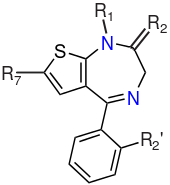Thienodiazepines
A thienodiazepine is a heterocyclic compound containing a diazepine ring fused to a thiophene ring. Thienodiazepine forms the central core of several pharmaceutical drugs.

Since thienodiazepines interact with the benzodiazepine receptor site, they typically have similar effects as benzodiazepines and can be considered as essentially identical.
Subjective effects
The effects listed below are based upon the subjective effects index and personal experiences of PsychonautWiki contributors. The listed effects will rarely (if ever) occur all at once, but heavier dosages will increase the chances and are more likely to induce a full range of effects. These effects are listed and defined in detail within their own dedicated articles below:
- Sedation
- Amnesia
- Thought deceleration
- Disinhibition
- Delusions of sobriety - This is the false belief that one is perfectly sober despite obvious evidence to the contrary such as severe cognitive impairment and an inability to fully communicate with others.
- Euphoria
- Information processing suppression
- Dizziness
- Motor control loss - Lack of coordination may result in falls and injuries, in particular, in the elderly. Another result of motor control loss is the impairment of driving skills and the increased likelihood of road traffic accidents.
- Muscle relaxation
Paradoxical effects
Paradoxical reactions such as increased seizures (in epileptics), aggression, increased anxiety, violent behavior, loss of impulse control, irritability and suicidal behavior sometimes occur with the use of benzodiazepines (although they are rare in the general population, with an incidence rate below 1%).[1][2] These paradoxical effects occur with greater frequency in recreational abusers, individuals with mental disorders, children, and patients on high-dosage regimes.[3][4] The paradoxical effects may be associated with thienodiazepines due to their similarity to benzodiazepines.
Examples
Toxicity and harm potential
Benzodiazepines and thienodiazepines are essentially identical in their pharmacological action, subjective effects, toxicity and harm potential. They can therefore be treated similarly in the appropriate efforts necessary to maximize harm reduction.
Lethal dosage
The median lethal dosage varies wildly between specific substances within the thienzodiazepine class. It is because of this that one should always fully research the substance before administering it to themselves or others.
Tolerance and addiction potential
Tolerance will develop to the sedative-hypnotic effects within a couple of days.[6] Withdrawal symptoms or rebound symptoms may occur after ceasing treatment abruptly following a few weeks or longer of steady dosing, and may necessitate a gradual dose reduction.[7] [8]
Discontinuation
It is notoriously difficult to discontinue use of thienodiazepines and potentially life-threatening for tolerant individuals using regularly to do so without tapering their dose over a period of weeks. Thienodiazepines are positive allosteric modulators of GABA receptors so, as the brain is calibrated to operate with higher than usual inhibition, the number of GABA receptors expressed is reduced via downregulation. Abrupt discontinuation following chronic use of benzodiazepines causes rebound stimulation which presents as anxiety, insomnia and restlessness while the body attempts to return to homeostasis.
There is an increased risk of seizure following the discontinuation of thienodiazepines. Drugs which lower the seizure threshold such as tramadol should be avoided during withdrawal. It is safest to reduce the dose each day by a very small amount for a couple of weeks until close to abstinence. Small amounts of ethanol can also help to reduce the symptoms.
The duration and severity of symptoms depends on a number of factors including the half life of the drug used, tolerance and the duration of abuse. Major symptoms will usually start within just a few days after discontinuation and persist for around a week for shorter lasting thienodiazepines. Thienodiazepines with longer half-lives will exhibit discontinuation symptoms with a slow onset and extended duration.
See also
References
- ↑ http://www.ncbi.nlm.nih.gov/pubmed/18922233 | Saïas T, Gallarda T | Paradoxical aggressive reactions to benzodiazepine use: a review
- ↑ Paton C | Benzodiazepines and disinhibition: a review | Psychiatr Bull R Coll Psychiatr | http://pb.rcpsych.org/cgi/reprint/26/12/460.pdf
- ↑ Bond AJ | Drug-induced behavioural disinhibition: incidence, mechanisms and therapeutic implications | CNS Drugs
- ↑ Drummer OH | Benzodiazepines—effects on human performance and behavior | Forensic Sci Rev
- ↑ Development of a rational scale to assess the harm of drugs of potential misuse | http://www.sciencedirect.com/science/article/pii/S0140673607604644
- ↑ Principles and Practice of Psychopharmacotherapy | http://books.google.com/books?id=_ePK9wwcQUMC&pg=PA535
- ↑ Clinical Pharmacology, Clinical Efficacy, and Behavioral Toxicity of Alprazolam: A Review of the Literature | http://onlinelibrary.wiley.com/doi/10.1111/j.1527-3458.2004.tb00003.x/pdf
- ↑ The American Psychiatric Publishing Textbook of Substance Abuse Treatment | http://books.google.com/books?id=6wdJgejlQzYC&pg=PA222&hl=en#v=onepage&q&f=false